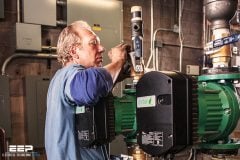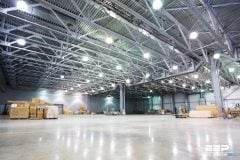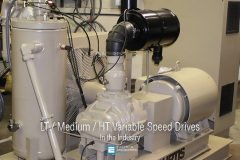Investment and Operating Costs
Flexibility, utilisation value and energy saving are the three main requirements for utility buildings (administration, office and public buildings, schools, hospitals, etc.). Apart from recouping investment costs, so-called life-cycle costs are also becoming increasingly important.
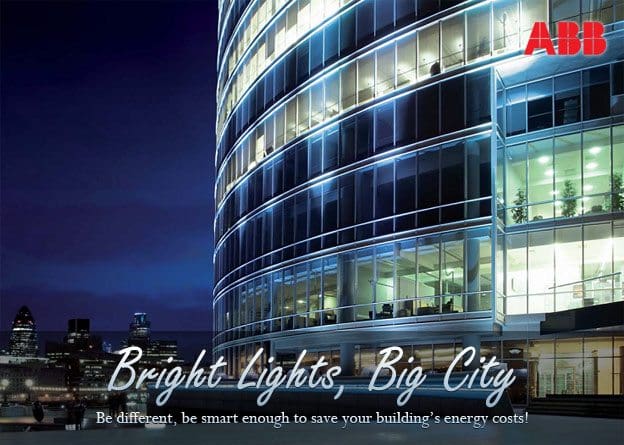
These are made up of the investment costs (construction costs and planning) and all operating costs arising during the life of a building. During the planning and construction phase of a new building, keeping to the planned building costs often becomes an issue.
Nobody seems, however, to be looking at the future operating costs although, according to a study produced by A.T. Kearney, these can be up to 20% of the construction cost each year. This percentage gen-erally rises as a result of increasing flexible use requirements.
On average, operating costs have exceeded investment costs after seven years.
Reducing the costs? You bet!
The use of EIBs – KNX not only reduces operating costs as shown in the actual examples below – but also increases the flexibility as well as the utilisation value of a building. Both are important factors that can be quantified, using actual examples. Due to the flexibility of the system, investment costs
are recouped with every modification of the facilities. The utilisation value does, on the other hand, directly affects the ongoing operation.
A comfortable room climate (room temperature and light quality) does, for instance, significantly increase the performance and motivation of employ-ees. The cost of service personnel is also reduced by central monitoring functions.
Ok, how to achieve potential savings?
The following energy-saving potentials exist in utility buildings and can be easily used with the EIB.
Presence detection
Considerable potential savings can be made in regulating lighting and heating in accordance with the requirements.
In other words, rooms are only heated if occupied by a person and are only illuminated if also a certain (preset) brightness level is not achieved.

Constant brightness control
Experience has shown that a constant brightness con-trol can save 35 to 50% of energy costs. The life of lamps is also significantly increased whilst the comfort (and thus efficien-cy) i.e. for office staff is increased.
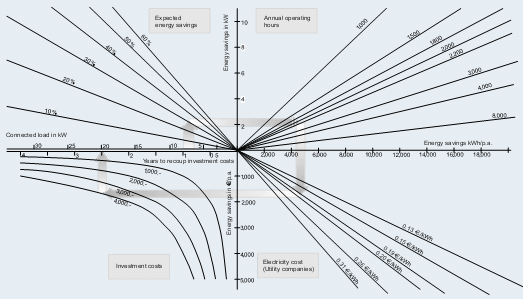
Individual room temperature control
The advantages are obvious: In case of the temperature being lowered by 1°C an energy saving of 6% can be achieved. At the same time, the comfort and performance of persons is increased.
If the heating control is com-bined with a presence detec-tor, further potential savings can be made.

This technical article first of all shows the maximum potential savings achievable with lighting and heating controls. Using a cost table, the period for recouping the investment for a controlled office system is shown. The savings are based on the graphic”Fördergemein-schaft Gutes Licht“.
The potential savings of individual light management components adds up to 82%.

The calculated potential savings refer to an office building with a 20 m2 user area with 4 switched or controlled 58 W light units.
The life of the light units fluctuates due to the use of the control gear. Lights with conventional control gear have a lower life (8,000 h) compared to lights with electronic control gear (16,000 h). Due to the low number of operating hours of a controlled lighting system, maintenance costs are also reduced so that the cost of installing ECGs is quickly recouped.
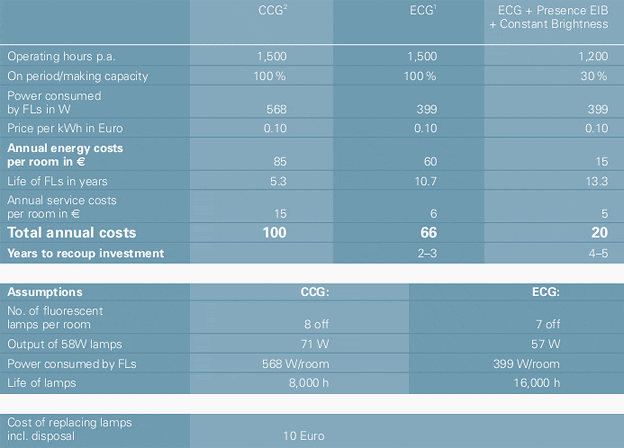
.
1 Electronic control gear
2 Conventional control gear
Example to illustrate all above
A large administration building requires an investment of 14 million €. The annual operating costs amount to 2 million €. Over a lifetime of 20 years, the following life-cycle costs are generated:
If as a result of an additional investment cost of 500.000 €, operating cost savings of 10% are achieved, the following life-cycle costs are generated:
(14 + 0.5 million € + 20 · (2 million € – 10%) = 14.5 million € + 20 · 1.8 million € = 50.5 million €
In other words, an additional investment of 0.5 million € reduces life-cycle costs by 3.5 million €



